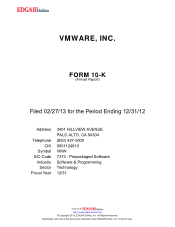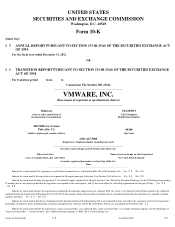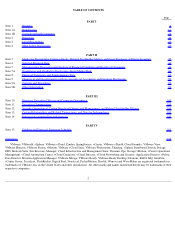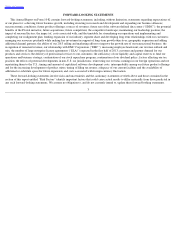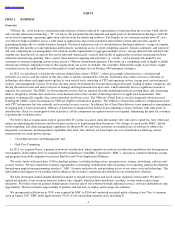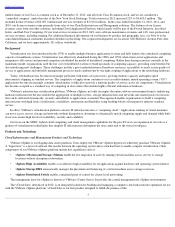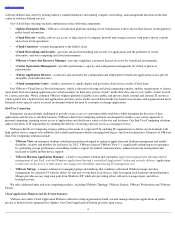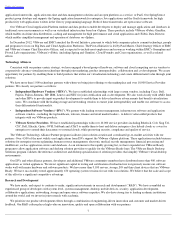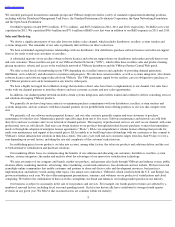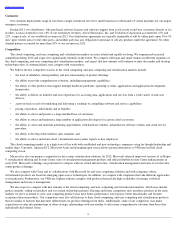VMware 2012 Annual Report Download - page 7
Download and view the complete annual report
Please find page 7 of the 2012 VMware annual report below. You can navigate through the pages in the report by either clicking on the pages listed below, or by using the keyword search tool below to find specific information within the annual report.
Table of Contents
million shares of our Class A common stock as of December 31, 2012, and all of our Class B common stock, and we are considered a
“controlled company” under the rules of the New York Stock Exchange. Total revenues in 2012 increased 22% to $4,605.0 million . This
included license revenues of $2,087.0 million and services revenues of $2,518.0 million . In the years ended December 31, 2012, 2011, and
2010, our license revenues came primarily from sales of our Cloud Infrastructure and Management solutions. The balance of our license
revenues came from our other solutions, including Cloud Application Platform, which largely will be part of the Pivotal Initiative, described
below, and End-User Computing. Of our total services revenues in 2012, 86% were software maintenance revenues and 14% were professional
services revenues, including training. For additional financial information on our business by product and geographic area, see Note O to the
consolidated financial statements included elsewhere in this filing. Our corporate headquarters are located at 3401 Hillview Avenue, Palo Alto,
California, and we have approximately 101 offices worldwide.
Background
Virtualization was first introduced in the 1970s to enable multiple business applications to share and fully harness the centralized computing
capacity of mainframe systems. Virtualization was effectively abandoned during the 1980s and 1990s when client-server applications and
inexpensive x86 servers and personal computers established the model of distributed computing. Rather than sharing resources centrally in the
mainframe model, organizations used the low cost of distributed systems to build up islands of computing capacity, providing some benefits but
also introducing new challenges. These challenges include a gross underutilization of hardware resources, an inability to easily assure quality of
service to applications and unwieldy management processes made cumbersome by the tight coupling of applications to the underlying hardware.
Today, x86 hardware has become increasingly proficient with multi-core processors, growing memory capacity and higher speed
interconnects shipping in standard servers. The complexity of applications continues to rise as multi-element, mixed operating system (“OS”)
applications become increasingly common, which makes it difficult to provide a uniform quality of service across all components. Virtualization
has become accepted as a standard way of computing in data centers that enables highly efficient utilization of hardware.
VMware's infrastructure virtualization platform, VMware vSphere, not only decouples the entire software environment from its underlying
hardware infrastructure but also enables the aggregation of multiple servers, storage infrastructures and networks into shared pools of resources
that can be delivered dynamically, securely and reliably to applications as needed. This approach enables organizations to build a computing
infrastructure with high levels of utilization, availability, automation and flexibility using building blocks of inexpensive industry-standard
servers.
In effect, VMware's virtualization platform converts IT infrastructure into a “computing cloud.” Applications running in virtual machines
can move across servers, storage and networks without disruption or downtime to dynamically match computing supply and demand while built-
in services ensure high levels of availability, security and scalability.
Our focus on the SDDC, hybrid cloud computing, and client management capabilities for the post-PC era is an expansion of our role as a
pioneer of virtualization technologies that simplify IT infrastructure throughout the data center and to the virtual workspace.
Products and Technology
Cloud Infrastructure and Management Products and Technology
VMware vSphere is our flagship data center platform. Users deploy the VMware vSphere hypervisor when they purchase VMware vSphere.
A “hypervisor” is a layer of software that resides between the operating system and system hardware to enable compute virtualization. Other
components of our VMware vSphere platform include key capabilities such as:
The management layer for vSphere is known as VMware vCenter Server. It provides the central management for vSphere environments.
The vCloud Suite, introduced in 2012, is an integrated solution for building and managing a complete cloud infrastructure optimized for use
with the VMware vSphere platform. vCloud Suite is our first product designed to fulfill the promise of the
5
• vSphere vMotion and Storage vMotion enable the live migration of actively running virtual machines across servers or storage
locations without disruption or downtime.
• vSphere High Availability enables cost-
effective high availability for all applications against hardware and operating system failures.
• vSphere Storage DRS
automatically manages the placement and balancing of a virtual machine across storage resources.
• vSphere Distributed Switch enables centralized point of control for cluster-
level networking.

